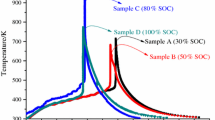Abstract
In view of availability, accountability, and applicability, LiFePO4 cathode material has been confirmed to be better than LiCoO2 cathode material. Nevertheless, few related researches were conducted for thermal runaway reaction of the LiFePO4 batteries. In this study, vent sizing package 2 (VSP2) and differential scanning calorimetry were employed to observe the thermal hazard of 18650 lithium-ion batteries and their content—LiFePO4 cathode material, which were manufactured by Commercial Battery, Inc. Two states of the batteries were investigated, which was charged to 3.6 V (fully charged) and 4.2 V (overcharged), respectively, and important parameters were obtained, such as self-heating rate (dT dt −1), pressure-rise rate (dP dt −1), and exothermic onset temperature (T 0). The results showed that T 0 for fully charged is about 199.94 °C and T max is about 243.23 °C. The entire battery for LiFePO4 cathode material is more stable than other lithium-ion batteries, and an entire battery is more dangerous than a single cathode material. For process loss prevention, the data of battery of VSP2 test were applied as reference for design of safer devices.






Similar content being viewed by others
Abbreviations
- T 0 :
-
Initial exothermic temperature (°C)
- dT dt −1 :
-
Self-heating rate (°C min−1)
- dP dt −1 :
-
Pressure-rise rate (bar min−1)
- P max :
-
Reaction maximum pressure (bar)
- T max :
-
Reaction maximum temperature (°C)
- ΔH d :
-
Decomposition of heat (J g−1)
- V:
-
Voltage (V)
- CC:
-
Constant current (A)
- CV:
-
Constant voltage (V)
- A:
-
Ampere (A)
- Mass:
-
Mass of sample before VSP2 experiment (g)
References
Hu C, Youn BD, Chung J. A multiscale framework with extended Kalman filter for lithium-ion battery SOC and capacity estimation. Appl Energy. 2012;92:694–704.
Julien C. Design considerations for lithium batteries. In: Julien C, Stoynov Z, editors. Materials for lithium-ion batteries. Netherlands: Kluwer Academic Publishers; 2000. p. 1–20.
Chen GI, Richardson TJ. Thermal instability of olivine-type LiMnPO4 cathodes. J Power Sources. 2010;195:1221–4.
Lee SH, Jung JM, Ok JH, Park CH. Thermal studies of charged cathode material (LixCoO2) with temperature-programmed decomposition–mass spectrometry. J Power Sources. 2010;195:5049–51.
Wang YD, Jiang JW, Dahn JR. The reactivity of delithiated Li(Ni1/3Co1/3Mn1/3)O2, Li(Ni0.8Co0.15Al0.05)O2 or LiCoO2 with non-aqueous electrolyte. Electrochem Commun. 2007;9:2534–40.
Gnanaraj JS, Zinigrad E, Asraf L, Gottlieb HE, Sprecher M, Aurbach D, Schmidt M. The use of accelerating rate calorimeter (ARC) for the study of the thermal reactions of Li-ion battery electrolyte solutions. J Power Sources. 2003;119–21:794–8.
Adams S. Ultrafast lithium migration in surface modified LiFePO4 by heterogeneous doping. Appl Energy. 2012;90:323–8.
He H, Xiong R, Guo H. Online estimation of model parameters and state-of-charge of LiFePO4 batteries. Appl Energy. 2012;89:413–20.
http://www.tvbs.com.tw/news/news_list.asp?no=sunkiss20110505125757. Accessed 05 May 2011.
BYD shares in China and Hong Kong recover following exploding taxi incident. http://autonews.gasgoo.com/china-news/byd-shares-in-china-and-hong-kong-recover-followin-120531.shtml. Accessed 31 May 2012.
Battery fluid leak may be a factor in China car fire. http://autonews.gasgoo.com/china-news/battery-fluid-leak-may-be-a-factor-in-china-car-fi-120608.shtml. Accessed 08 June 2012.
Jhu CY, Wang YW, Wen CY, Chiang CC, Shu CM. Self-reactive rating of thermal runaway hazards on 18650 lithium-ion batteries. J Therm Anal Calorim. 2011;106:159–63.
Jhu CY, Wang YW, Shu CM, Chang JC, Wu HC. Thermal explosion hazards on 18650 lithium-ion batteries with a VSP2 adiabatic calorimeter. J Hazard Mater. 2011;192:99–107.
Saito Y, Takano K, Negishi A. Thermal behaviors of lithium-ion cells during overcharge. J Power Sources. 2001;97–8:693–6.
Tobishima SI, Yamaki JI. A consideration of lithium cell safety. J Power Sources. 1999;81–2:882–6.
Tobishima SI, Takei K, Sakurai Y, Yamaki JI. Lithium ion cell safety. J Power Sources. 2000;90:188–95.
Li G, Yang Z, Yang W. Effect of FePO4 coating on electrochemical and safety performance of LiCoO2 as cathode material for Li-ion batteries. J Power Sources. 2008;183:741–8.
MacNeil DD, Lu ZH, Chen ZH, Dahn JR. A comparison of the electrode/electrolyte reaction at elevated temperatures for various Li-ion battery cathodes. J Power Sources. 2002;108:8–14.
Commercial 18650 LiFePO4 batteries. http://www.a123systems.com/.
Kweon HJ, Park JJ, Seo JW, Kim GB, Jung BH, Lim HS. Effects of metal oxide coatings on the thermal stability and electrical performance of LiCoCO2 in a Li-ion cell. J Power Sources. 2004;126:156–62.
STARe Software with Solaris Operating System. Operating instructions. Sweden: Mettler Toledo; 2004.
FAI/06-90. VSP2 User’s Manual & Test Methods (Software Version 4.3). Burr Ridge: Fauske & Associates, LLC; 2006.
Chen KY, Chen WT, Chiu CW, Wu TC, Shu CM. Thermal explosion simulation of methyl ethyl ketone peroxide in three types of vessel under the same volume by explosion models. J Therm Anal Calorim. 2011;106:235–41.
Chu YC, Chen JR, Tseng JM, Tsai LC, Shu CM. Evaluation of runaway thermal reactions of di-tert-butyl peroxide employing calorimetric approaches. J Therm Anal Calorim. 2011;106:227–34.
Liang YC, Jhu CY, Wu SH, Shen SJ, Shu CM. Evaluation of adiabatic runaway reaction of methyl ethyl ketone peroxide by DSC and VSP2. J Therm Anal Calorim. 2011;106:173–7.
Wu SH, Shyu ML, YP I, Chi J, Shu CM. Evaluation of runaway reaction for dicumyl peroxide in a batch reactor by DSC and VSP2. J Loss Prev Process Ind. 2009;22:721–7.
Shu CM, Yang YJ. Using VSP2 to separate catalytic and self-decomposition reactions for hydrogen peroxide in the presence of hydrochloric acid. Thermochim Acta. 2002;392–393:259–69.
Acknowledgements
The authors are indebted to Mr. S.Y. Guan for his technical support in this study.
Author information
Authors and Affiliations
Corresponding author
Rights and permissions
About this article
Cite this article
Wen, CY., Jhu, CY., Wang, YW. et al. Thermal runaway features of 18650 lithium-ion batteries for LiFePO4 cathode material by DSC and VSP2. J Therm Anal Calorim 109, 1297–1302 (2012). https://doi.org/10.1007/s10973-012-2573-2
Published:
Issue Date:
DOI: https://doi.org/10.1007/s10973-012-2573-2




